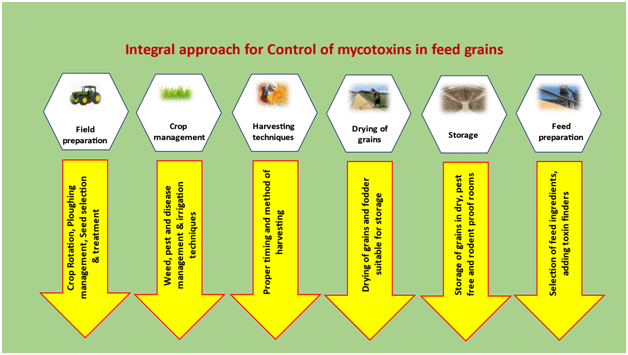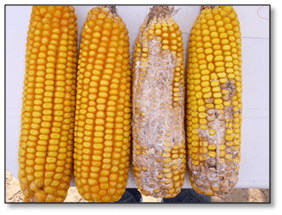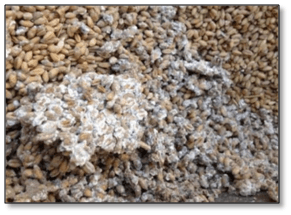Dr.R. Selvakkumar, M.V.Sc., Ph.D, Dr. A. Rajadurai, M.V.Sc., & Dr. K. Chinnamani, M.V.Sc., Ph.D
Tamil Nadu Veterinary and Animal Sciences University Veterinary College and Research Institute
Mycotoxins are one of the key challenges faced by the poultry industry in India as it leads to serious economic losses. Tropical climate of our country with hot and humid conditions, poor post harvesting technology, inadequate drying and poor storage facilities make the feedstuff susceptible to fungal contamination. Further, poor management practices in the field level followed by the poultry farmers, further worsen the situation.
Mycotoxins are the secondary metabolites with low molecular weight produced by the filamentous fungi and the Aspergillus spp, Penicillium spp and Fusarium spp areresponsible for the production of the majority of the mycotoxins. Mycotoxins affect many of the poultry and livestock species. Important mycotoxins that affect the immune system of poultry are Aflatoxins, ochratoxins and trichothecenes. From the toxicological and economical point of view, five mycotoxin groups are currently significant in the poultry industry.
Major fungi and its mycotoxins that affect poultry feed ingredients
| S.No | Mycotoxins produced | Name the fungi | Affected feed ingredients |
| 1 | Aflatoxin B1, B2, G1& G2 | Aspergillus flavus Aspergillus parasiticus Aspergillus nomius | Wheat, maize, rice, peanuts, oilseeds & cotton seed |
| 2 | Ochratoxin A | Aspergillus carbonarius Aspergillus niger Aspergillus ochraceus Penicillium verrucosum Penicillium nordicum Aspergillus flavus Aspergillus parasiticus Aspergillus nomius | Wheat, barley, oats |
| 3 | Trichothecenes | Fusarium sporotrichiodes Fusarium langsethiae Fusarium graminearum Fusarium culmorum Fusarium cerealis | Maize, wheat, barley, oats, grains |
| 4 | Zearalenone | Fusarium Graminearum Fusariumlangsethiae Fusariumsporotrichiodes Fusarium culmorum Fusarium cerealis | Maize, wheat, barley, oats and grains |
| 5 | Fumonisin B1, B2& B3 | Fusarium verticillioides Fusarium proliferatum | Maize, rice, wheat, sorghum, oats & barley |
Effect of mycotoxins
- The aflatoxins are carcinogenic metabolites in poultry primarily affecting the liver but can involve immunologic, digestive, and hematopoietic functions.
- Aflatoxin contamination will results in reduction in weight gain, reduction of feed intake, reduction of feed conversion efficiency, blood clotting disorders, reduction in egg production, reduction of fertility and impairment of defence mechanism
- Ochratoxins have nephrotoxic, hepatotoxic, teratogenic and immunotoxic effects and affect several animal species. Chicken and turkey are affected by this toxin. Generally, young poultry is more sensitive to ochratoxins than mature birds. The toxic effects of Ochratoxins include inhibition of protein synthesis. Impairment of Ca homeostasis, DNA damage, destruction of digestive enzyme and reduced immunity. The all above will result in Kidney damage, polydipsia, poor quality of egg shell, reduced feed intake, reduced production and immune suppression.
- Trichothecenes are classified as gastrointestinal toxins, immunotoxins, dermatotoxins and hemotoxins and this mycotoxins causes oral and cutaneous lesion, reduction of egg weight, increase the abnormality in egg shells, immunosuppression and decrease in production.
- The risk of mycotoxins depends on the level of major mycotoxins, co- occurrence and level of other mycotoxins the age and health status of the flocks.
FACTORS AFFECT MYCOTOXIN PRODUCTION
Climatic factor (Temperature,Water activity,relative humidity)
Climate factors play an important role in determining fungal infection in plants. Activity of the fungi and their mycotoxins production are much determined by predominant environmental conditions like humidity and temperature.
Unsuitable temperature and humidity affect plant growth, strength, and health and influence the competitiveness of mycotoxigenic fungi and this will favours the fungal growth.
We can’t tell, a single climatic factor is responsible for the fungal growth. Due to differences in environmental conditions and growth requirements, fungal development and level of mycotoxin production differences among different climatic regions.
During favourable humidity and temperature conditions, the fungal invasion can take place at any stage from field to storage.
Surrounding pH
The pH surrounding the medium of the fungus plays a vital role in the growth and production of toxins by them. The fungus also has a capacity to change the surrounding pH by secreting acid or alkaline substances and make the pH ideal for its growth.
Fungal strain
Between the fungal species, the toxicity and the amount of mycotoxins production differ and sometimes it varies within the species. The temperature, humidity and nutrient requirement for the favourable growth of fungus varies between and within the species.
Substrate
The fungi that produce mycotoxins can grow on various types of substrates and widely found in food items especially ones rich with carbohydrates. But we can’t tell that, a substrate that is suitable for mould growth is also suitable for the production of mycotoxins by the fungus. A combination of factors is essential for the growth and mycotoxin production by the fungus.
MYCOTOXIN CONTROL AND PREVENTION STRATEGY
At present, no method is available for the complete eradication of mycotoxin. Because, various types of mycotoxins are produced by various types of fungus at various climatic conditions. So, prevention of mycotoxins in this diverse lifecycleis very difficult. Even though, an integrated approach by implementingappropriate quality practices from the start to end will minimize mycotoxins frequency in the end product.
INTEGRATED APPROACH FOR MINIMIZE THE MYCOTOXIN PRODUCTION
Integrated approach starts from the agriculture field and ends before feeding to the animals/ birds. Because, the fungus may be attacked in any one or combination or in all the stages listed below.
- Field
- In the field with crop
- Harvest
- Drying
- Storage
- Process / Decontamination
Agricultural field preparation to minimize the mycotoxin production
- If the previous crop in the agriculture field was infected by the fungus, there is more chance to infect the new seeds sowing in the next time. So, the field should be properly prepared before sowing the seeds to minimize the fungal infection. Deep ploughing will turn the soil upright, and this will move the remains of the infected crops deep in to the ground and prevent the fungal attack on the new seeds.
- The selected seeds should be disease tolerant as well as withstand in all climatic conditions. Seed should be properly treated before sowing.
- Sowing of seeds should be planned in such a way to harvest them prior to the monsoon rain.

In the field with crop
Once the seeds start to germinate, we should follow proper agronomic practices until harvest. Any lacunae, at any one stage will open the doors for fungal attack.
Applying proper soil nutrients through fertilizers, watering in a proper interval and timely weeding will make the plant healthy and reduce the chance of fungal contamination. Proper insect control is also essential to restrict the spread of contamination to healthy crops in case of fungal infection. Further, the insects may cause physical damage to the plant parts and the affected plants are more prone to the fungal attack.
Proper harvest practices
Proper harvesting methods and time are the vital factors to get a toxin free final product. Because, there is more possibilities of fungal contamination when we don’t follow a proper harvesting method. The moisture content of the plant should be checked before storage to get a better post harvest product. Harvest should always be done on sunny days and drying should be done as quickly as possible to get a desirable moisture content.
Drying
Storage
Even though, we cultivate and collect healthy crops and grains with optimum moisture content, improper storage will easily contaminate the product and spoil all our efforts. So, utmost care should be taken during storage. The storage place should be free from any contamination. The humidity and temperature should be maintained with an optimum level to avoid the fungal growth. To avoid the chillness and moisture content from the floor surface and wall, a physical barrier may be placed on the floor and kept the goods on them. Storage structure should be rodent proof. Before storage the entire storage building should be disinfected. Periodical checking of the physical property of the stored goods should be done. The floor and wall should be impermeable.
Detoxification of mycotoxins in feeds and feed ingredients
Though we take all measures to reduce the mycotoxin production in plants in all stages, there is a possibility of contamination of feed in feed factories and animal houses which are not mentioned above. So, we should detoxify the mycotoxins by a suitable detoxification method via physical or chemical or biological methods. Present day, there are so many toxin finding agents are available in the market and it should be used without altering the nutritive composition of the feed.
Fungal invasion in food might not be unavoidable and unpredictable and its presence could definitely be a threatening factor for livestock and poultry industry. Though, the implementation of an integrated approach from the beginning of the food chain until the end will help to reduce the possibilities of fungal contamination.

